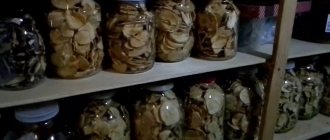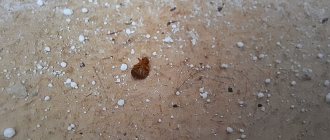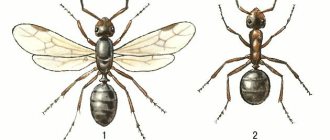Development and reproduction of ants
- Fact:
The female is fertilized once; she will use this seminal fluid throughout her life. - Fact 2:
Until the first population of worker ants appears, the queen does not eat anything; she feeds the larvae with the contents of her fatty glands, from which she feeds herself. - Fact 3:
The body of a worker ant has a durable chitinous shell and three distinct sections: head, belly, and sternum. - Fact 4:
The queen queen lives the longest, for two decades. But there were also cases of longer life expectancy. The recorded maximum is 28 years.
In every ant colony there is a clear hierarchy. One can only envy such a structured and organized community. Each family member has his own status, his own role, his own responsibilities and even a diet according to his needs.
Reproduction
The honorable responsibility to increase the size of the colony rests with the queen . She is royalty and does nothing but lay eggs. She is protected, guarded, and some species even chew food for her.
How to become a queen? During summer (mating season), certain females and males acquire wings and fly out of the anthill to mate. The female is fertilized once; she will spend this seminal fluid throughout her life . Males die either after an act of love, or they are destroyed by their relatives themselves as unnecessary.
After fertilization, the female looks for a suitable place for the first egg laying. If everything goes well (she will not die, will not become a victim of bird hunting, and will be able to make a full clutch), then “Vivat Queen!”, the foundation of the future underground ant kingdom is ready. After 14-20 days, the egg clutch will pupate, and after another 25-40 the first ants will appear. This is a working group. He will begin to build and expand the anthill, store food and care for the next generation of ants. The female chews off her wings and from now on is only engaged in reproducing new members of the colony.
Until the first population of worker ants appears, the queen does not eat anything; she feeds the larvae with the contents of her fatty glands, from which she feeds herself.
Reproduction
In a residential apartment, house ants begin to multiply quickly, creating several colonies at the same time. Each nest contains several mature queens. The queen mates once in her lifetime. Initially, the queen emerges from the pupa with wings. After the mating flight, she bites them off, turning into a wingless insect.
After mating, she looks for a warm and dry place to build her nest. A fertilized queen lays eggs throughout her life. The egg laying process continues at short intervals. The ant colony includes the following species categories of insects:
- worker ant;
- ant queen;
- male drones.
Males emerge from unfertilized eggs laid by the queen. In an anthill that has existed for many years, males are constantly born. They differ in size and the presence of wings, which they need for mating flight. The role of males is reduced to insemination of the uterus. Unlike queens, which live for several years, males die almost immediately after breeding.
Fact! House ants are capable of reproducing extremely quickly; under favorable conditions, the number of colonies in an apartment reaches more than 10,000 individuals.
After 3 weeks, ant larvae emerge from the egg clutch and pupate after some time. When the colony reaches a certain size, several worker ants with larvae and pupae separate from it. One queen leaves with the worker ants. This is how another colony is formed in the apartment in a new place.
Stages of ant development: from egg to adult
An ant is an insect with all the stages of transformation inherent in it:
- Egg.
- Larval form.
- Pupation.
- Adult ant.
The queen lays eggs in groups of several dozen eggs. When the incubation period expires, a new form will be born - larvae. They look like small worms and only at this stage they absorb food around the clock and increase in mass and size. Small larvae lead a group existence, while large ones live separately.
The next stage of transformation is the formation of a pupa. Before modification, the larva does not eat and excretes excrement in the form of a ball (they are then located at the end of the pupa). After the time spent in the pupa has expired, a full-fledged adult ant emerges from it. But he himself cannot leave the solid walls of the cocoon; his fellow tribesmen help him get out. The newborn has a colorless body, which becomes the color characteristic of this species only after a few days. From the moment the young insect acquires its specific color, it stops growing. All stages of transformation take about a month.
Stages of development of pharaoh ants
Eggs,
which the queen lays look like
small oval spheres
.
They have a white or coffee tint. about 3 weeks
for the larvae to appear .
Larvae
appear
small,
completely
helpless.
In purely external terms, they look like
worms,
whose dimensions barely exceed
1-1.5 mm
.
Despite their weakness, they eat a lot
, growing rapidly.
Compared to adults, these larvae eat approximately 5-6 times more
relative to their body weight.
And at the same time, they are not yet a full-fledged workforce; there is no benefit from them. All forces are devoted to growth, and if the food is adequate (and the miners take care of this), then soon the larvae begin to pupate.
This happens in about 20-25 days
after the larvae emerge from the eggs.
The larva is light and soft
to the touch.
Pharaoh ants are a species that can for themselves
. This ensures rapid and complete development.
During the pupal
The young ant
does not feed
, but actively excretes waste products. No surprise, remember how much the insect ate during the larval stage! This waste accumulates near the lower tip of the cocoon in the form of a dark lump.
After 6 weeks
an adult
emerges from the pupa .
She is hungry and strong
, completely ready for
the hard
work of ants.
But there is a problem - they are not able to get out of the cocoon on their own
. It’s okay, older relatives will happily come to the rescue. They chew the shell with their sharp mandibles and greet their younger brother in unison.
Initially young
the insect
is colorless,
it is almost transparent.
But 3-5 days
after emerging from the pupa, the ant acquires
a color
characteristic of its species. In the case of “our” pharaoh ants, she is red.
Interesting.
No matter how much food an adult pharaoh ant consumes, it will not grow anymore. Not all species have this feature. For example, some tropical varieties spend their entire lives growing, albeit just a little.
Structure of the torso and brain
The ant has a rather complex organism. All numerous species are approximately identical in structure. Worker ants do not have wings, but females and males do during the mating season.
The body of a worker ant has a durable chitinous shell and three distinct sections: head, belly, sternum . The head has different shapes and sizes depending on the species. The head is equipped with eyes consisting of numerous lenses. The organs of vision do not see objects, but recognize movement. In addition, there is a small additional pair of eyes to determine the degree of illumination.
Ants use their antennae to communicate. They recognize odors, detect air currents, vibrations, and decipher touches. Some species have a sting on their belly. It is necessary for protection, hunting or attack.
Three pairs of limbs are equipped with claws. With their help, the ant easily overcomes vertical ascent.
Lifespan of ants by species
Ants are the most common insect species on earth, the total number of which is divided into 13.5 thousand species. And 300 species of them live in Russia. Insects lead a social life and cannot exist alone.
The lifespan of ants is genetically determined depending on their membership in a certain caste, which is determined at birth and does not change throughout their existence: workers, queens and males.
How many years do ants live,
depends on the type and living conditions of the insect. The size of the individual also affects its lifespan: the larger the ant, the greater the chance of living longer.
The inhabitants of mixed forests are rightfully considered to be orderlies - a large anthill can protect a hectare of forest from pests. Ants feed their larvae with pupae of harmful insects, collecting several thousand pieces in one day. Colonies of aphids, which are raised by ants to collect the sweet juice produced by insects, can be called harmful.
The life of ants passes in an anthill made of twigs, pine needles, and forest debris. The height of the structure can reach two meters. Insects overwinter in the lower part of the structure, hibernating if the temperature inside is too low.
The life cycle of a working red ant is designed for 5 years, but almost no one lives to reach the deadline set by nature - forest birds love to feast on ants. Males, having fulfilled their function, die within a month. The queen is long-lived while she is in the anthill.
Red forest ants are listed in the Red Book. Forestry staff conducts an annual count of anthills.
The insect is distinguished by its body covered with villi. How do meadow ants live? They make their homes in open areas: forest edges, meadows. Winged females fly out twice a season to fertilize. The lifespan of a meadow insect is the same as that of its red forest counterpart. Ants that spend time in the middle of an anthill have a longer lifespan than those that go outside. The reason is the high mortality rate of working individuals from injuries and predators.
The pharaoh ant was brought from warm countries, so for its housing it chooses human houses in rural and urban areas. Insects do not build an anthill, but adapt cavities in the house for nesting. In multi-apartment buildings, pharaoh ants live in colonies numbering several thousand individuals, belonging to one family with a common leadership. The adult size reaches 3 mm.
The life expectancy of an ant is one of the lowest:
- females live 8-9 months;
- breeding males die within 20 days;
- working individuals exist for about 2 months.
The short lifespan of insects is compensated by a large number of queens in the nest, which can reproduce more than 30 thousand individuals per year.
The average development time for an ant from egg to adulthood is approximately 40 days. In the shortest possible time, pharaoh ants can colonize apartment buildings, creating nests in a place remote from humans.
Black garden
Ants live in nests built in the ground, with a characteristic mound on top. Rotten wood or a place under a stone is suitable for making a nest. Insects overwinter in the lower part of the structure, which is located half a meter from the surface. Arthropods also often settle in human homes, preparing food for the winter from food waste and crumbs.
Despite the natural life expectancy of working individuals of up to 3 years, in real conditions there is an almost complete renewal of the inhabitants of the anthill throughout the year.
Sexual characteristics
Development by gender has the following mechanism: fertilized eggs are future females, and unfertilized eggs are males. Having received seminal fluid once and for all, the uterus consumes it in portions, so not all eggs are fertilized, but only partially .
Eggs that do not receive a male chromosome have only the maternal chromosome set and in the future they will be guaranteed to be males. From fertilized eggs, there are two options for the development of females: either a female for further reproduction, or a soldier ant. The final result depends on diet and care.
Life cycle duration
The role an insect plays in its colony directly determines how long it will live.
A worker ant lives from 3 to 5 years . At the same time, smaller specimens take a little longer. Also, more life is given to those who perform the functions of a builder inside the anthill. Those whose duties include caring for the queen and larvae live less.
The males were less fortunate than the others. They are not needed as soon as they fulfill the role of a fertilizer. Moreover, they will be killed by their own relatives or die themselves after mating. Life cycle – 2-3 weeks.
The queen queen lives the longest, two decades. But there were also cases of longer life expectancy. The recorded maximum is 28 years.
Ant maternity hospital: how are ants born?
Irina Kozorog, macro photographer and member of our club, continues her stories about ants. This time we will talk about how exactly these insects are born, about which we know so little.
A few days ago I had the amazing opportunity to attend an extraordinary birth and even photograph it in the most inaccessible and therefore most mysterious maternity hospital in the world. Yes, yes, in the very same place where people are not allowed to enter and where creatures are born that are many times superior to humans in almost everything... I filmed the amazing work of obstetricians and the birth of ideal soldiers and professional workers; Today I am putting into the public domain everything that was so carefully hidden from people. The filming was carried out with a hidden camera; I think you will understand the risk I took for these shots and appreciate the report.
This is how the maternity hospital looks from the outside, that is, this is how we people see it
In ant dwellings everything is strict, there is always and everywhere absolute and unconditional order.
Ants have a maternity hospital, a nursery, a kindergarten, a warehouse where food is stored, and even a dining room. Believe it or not, there is even a park where dolls are sometimes taken for a walk, and a cemetery. I hope to make reports in due time about every corner of their huge home, but today we will talk exclusively about the maternity hospital, here it is.
Birth of an ant
Let's try to take a closer look at the ants... This is the maximum that a person can see. Yeah, the same person who is the coolest on planet Earth.
The birth process of an ant.
And you and I no longer see this, this is the direct process of childbirth.
The eggs are collected from under the queen by ants.
I can’t see exactly how they hold them together, but they carry them in handfuls like this.
Having collected the eggs, the ants take them to the nursery, where after some time they turn into larvae.
Actually, all three stages are visible here: in the background are eggs just turning into larvae; on the front there is a larva; and in the center is a pupa that has already gained color.
With rare exceptions, eggs and larvae are found in nurseries.
The larva turns into a pupa and is taken to kindergarten.
The ants hold the pupae upside down, hanging motionless for hours. Those dolls that lie below are waiting for their turn: they will soon be lifted up too. Many pupae are very, very large; Sometimes the ants keep them one at a time, but more often they keep them together.
When the doll begins to gain color, it leaves the kindergarten and goes to the maternity hospital.
Sometimes they bring here still completely transparent pupae, but they quickly darken.
The birth itself occurs quite quickly - 30, maximum 40 minutes.
Suddenly a lot of ants gather around the pupa, and it becomes very difficult to see what exactly they are doing. It seems that they are just concentrating on feeling it with their antennae, and that’s all.
If you look closely, you can see that the ants are removing the film from the pupa!
The film was removed from the doll.
Newborn ant
It is interesting that sometimes the pupa is taken from the maternity hospital immediately before birth and taken to the room where the future ant will work in the future. The newborn is given a few minutes to wash himself, and then his childhood ends. He gets involved in the work along with other ants.
This baby stayed to work in the maternity hospital.
(main photo)
This is how I got this amazing report. Did you like it?
Irina Kozorog’s website: www.kozorog.ru











